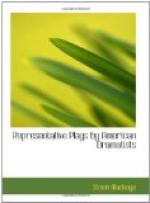Title: Representative Plays by American Dramatists: 1856-1911: Paul Kauvar; or, Anarchy
Author: Steele Mackaye
Release Date: July 23, 2004 [EBook #13006]
Language: English
Character set encoding: ASCII
*** Start of this project gutenberg EBOOK Paul Kauvar; or, anarchy ***
Produced by David Starner, Leah Moser and the Online
Distributed
Proofreading Team.
PAUL KAUVAR; OR, ANARCHY
[Illustration: Steele Mackaye]
STEELE MACKAYE
(1844-1894)
When one realizes the sociological purpose behind Steele Mackaye’s “Paul Kauvar; or, Anarchy,” it is interesting to note how inefficient the old form of drama was to carry anything more than the formal romantic fervour. Compared with John Galsworthy’s treatment in “Strife” and “Justice,” it makes one glad that realism came and washed away all the obscuring claptrap of that period. Daly, Boucicault, and their generation were held firmly in its grip; they could not get away from it, and they were justified in their loyalty to it by the insistent claim “The Two Orphans” and “The Lady of Lyons” had upon the public. All the more credit, therefore, that Bronson Howard, David Belasco, and James A. Herne escaped it; had the latter completely freed himself of melodrama, his plays would be better known to-day, better capable of revival, because of the true greatness of their simple realistic patches.
But where Mackaye vitalized the old style was in the vigour of his treatment. He loved the large scene, the mob movement; and he worked with a big brush. As Nym Crinkle, the popular New York World dramatic critic of the day, wrote: “Whatever else he may be, [he] is not a ‘lisping hawthorne bud’! He doesn’t embroider such napkins as the ‘Abbe Constantin’, and he can’t arrange such waxworks as ‘Elaine’. He can’t stereoscope an emotion, but he can incarnate it if you give him people enough.”
Mackaye’s mind was large, resourceful, daring—both in the opinions it upheld, and the practical theatrical innovations it introduced into the theatre, like the double stage for the little Madison Square playhouse, in New York, which was the precursor of such modern paraphernalia as came later with the foreign revolving stages. He always stood on the threshold of modernism, advocating those principles which were to fructify in the decades to follow him. Such pioneer spirit was evident in his ardent advocacy of Delsarte methods of acting; his own work as an actor was coloured and influenced by the master whose pupil he became in the early years of his career. When one recalls the methods of Wallack, and his shy approach toward anything which was “natural,” it seems very advanced to hear Mackaye echoing the Delsarte philosophy. This advocacy was nowhere better demonstrated than when, at a breakfast given him at the New York Lotos Club, he talked on the rationale of art for two hours, and held spell-bound the attention of Longfellow, Bryant, Louis Agassiz, James J. Fields, E.P. Whipple, Edwin Booth and others. He once said:




